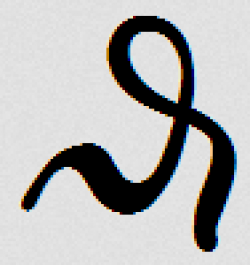
Human-transported material are indicated by a caret prefix (e.g., ^A-^C-Ab-Btb). This material has been moved horizontally onto a pedon from a source area outside of that pedon by purposeful human activity, usually with the aid of machinery or hand tools. The caret symbol (^) is used as a prefix to master horizon designations to indicate mineral or organic horizons formed in human-transported material. The prime symbol is added to the lower layers to differentiate them from the upper.

(when the soil has two identical C layers). The prime symbol is used only to distinguish two or more horizons that have identical symbols, e.g., Oi-C-O´i-C´ (when the soil has two identical Oi and C layers) and Oi-C-Oe-C´ These same principles apply in designating layers of organic soils. The sequenceA-E-Bt-E´-B´t1-B´t2-B´t3-C is an example. Vertical subdivisions of horizons or layers (number suffixes) are not taken into account when the prime symbol is assigned. In the rare cases where three layers have identical letter symbols, double prime symbols can be used for the lowest of these horizons, e.g., E´´. Used only with the lower 2Bw horizon (2B´w). In this example, the soil has two identical 2Bw horizons but twoĭifferent Bc horizons (a 2Bc and a 3Bc), so the prime symbol is The prime symbol is used for soils with lithologic discontinuities when horizons have identical designations, e.g.,A-C-2Bw-2Bc-2B´w-3Bc. It has two Bt master horizons of different lithologies thus, the Bt horizons are not identical and the prime symbol is not needed. The sequenceA-Bt1-Bt2- 2E-2Bt1-2Bt2 is an example. The prime symbol is not used unless all letters and number prefixes are completely identical. The prime symbol, where appropriate, is placed after the capital-letter horizon designation and before the lowercase suffix letter symbols that follow it, e.g., B´t. To emphasize this characteristic, the prime symbol (´) is added after the master-horizon symbol of the lower of the two horizons that have identical designations, e.g.,A-E-Bt-E´-Btx-C. For example, the sequenceA-E-Bt-E- Btx-C identifies a soil that has two E horizons. If two or more horizons with identical number prefixes and letter combinations are separated by one or more horizons with a different horizon designation in a pedon, identical letter and number symbols can be used for those horizons that have the same characteristics. Oa) or by the master horizon symbol if the different layers are mineral or limnic materials (e.g., Oa vs. In most cases such differences are identified either by letter-suffix designations if the different layers are organic materials (e.g., Oe vs. If the material in which a horizon of a buried soil has formed is lithologically unlike the overlying material, the discontinuity is indicated by a number prefix and the symbol for the buried horizon also is used, e.g.,Ap-Bt1-Bt2-BC-C- 2ABb-2Btb1-2Btb2-2C.ĭiscontinuities between different kinds of layers in organic soils are not identified. Some buried horizons, however, have formed in material that is lithologically like the overlying deposit.Aprefix is not used to distinguish material of such a buried horizon. It is obviously not in the same deposit as

If part of the solum has formed in residuum, the symbol R is given the appropriate prefix, e.g., Ap-Bt1-2Bt2-2Bt3-2C1-2C2-2R.Ī buried genetic horizon (designated by the letter b) presents special problems. The prefix is used, however, if it is thought that the R layer would produce material unlike that in the solum, e.g.,A-Bt-C-2R orA-Bt-2R. If an R layer is present below a soil that has formed in residuum and if the material of the R layer is judged to be like the material from which the soil has developed, the number prefix is not used. If other horizons intervene, another vertical numbering sequence begins for the lower horizons, e.g.,A-C1- C2-2Bw1-2Bw2-2C1-2C2. However, vertical subdivisions do not continue across lithologic discontinuities if the horizons are not consecutive or contiguous to each other. The suffix numbers designating vertical subdivisions of the Bt horizon continue in consecutive order across the discontinuity.


 0 kommentar(er)
0 kommentar(er)
